This site uses cookies as defined in our Cookie Policy, by continuing to use this site you agree to their use.
Continue
| Arrive | Depart | ||||||
| 17th17 | OctOct | 202727 | Lisbon, Portugal, embark on the Seven Seas Splendor | 07:00 | 17:00 | ||
Set on seven hills on the banks of the River Tagus, Lisbon has been the capital of Portugal since the 13th century. It is a city famous for its majestic architecture, old wooden trams, Moorish features and more than twenty centuries of history. Following disastrous earthquakes in the 18th century, Lisbon was rebuilt by the Marques de Pombal who created an elegant city with wide boulevards and a great riverfront and square, Praça do Comércio. Today there are distinct modern and ancient sections, combining great shopping with culture and sightseeing in the Old Town, built on the city's terraced hillsides. The distance between the ship and your tour vehicle may vary. This distance is not included in the excursion grades. | |||||||
| 18th18 | OctOct | 202727 | At Sea | ||||
| 19th19 | OctOct | 202727 | Cádiz, Spain | 07:00 | 22:00 | ||
Believed to be the oldest town on the Iberian Peninsula, the Andalusian port of Cádiz enjoys a stunning location at the edge of a six-mile promontory. The town itself, with 3,000 years of history, is characterised by pretty white houses with balconies often adorned with colourful flowers. As you wander around be sure to take a stroll through the sizeable Plaza de Espãna, with its large monument dedicated to the first Spanish constitution, which was signed here in 1812. Cádiz has two pleasant seafront promenades which boast fine views of the Atlantic Ocean, and has a lovely park, the Parque Genoves, located close to the sea with an open-air theatre and attractive palm garden. Also notable is the neo-Classical cathedral, capped by a golden dome. | |||||||
| 20th20 | OctOct | 202727 | Tangier, Morocco | 08:00 | 16:00 | ||
Tangier can trace its origins back to the Phoenicians and ancient Greeks. It was named after Tinge, the mother of Hercules’ son, and its beginnings are embedded in mythology. It was subsequently a Roman province, and after Vandal and Byzantine influences, was occupied by the Arabs with Spain, Portugal, France and England also playing a part in the city’s history. With such a diverse past it is perhaps not surprising that Tangier is such an individual city. Overlooking the Straits of Gibraltar, the city lies on a bay between two promontories. With its old Kasbah, panoramic views, elegant buildings, squares and places of interest, there is much to discover in both the new and old parts of the city. | |||||||
| 21st21 | OctOct | 202727 | Málaga, Spain | 07:00 | 22:00 | ||
As you sail into Malaga you will notice what an idyllic setting the city enjoys on the famous Costa del Sol. To the east of this provincial capital, the coast along the region of La Axarqua is scattered with villages, farmland and sleepy fishing hamlets - the epitome of traditional rural Spain. To the west stretches a continuous city where the razzmatazz and bustle creates a colourful contrast that is easily recognisable as the Costa del Sol. Surrounding the region, the Penibéetica Mountains provide an attractive backdrop overlooking the lower terraced slopes which yield olives and almonds. This spectacular mountain chain shelters the province from cold northerly winds, giving it a reputation as a therapeutic and exotic place in which to escape from cold northern climes. Malaga is also the gateway to many of Andalusia's enchanting historic villages, towns and cities. | |||||||
| 22nd22 | OctOct | 202727 | At Sea | ||||
| 23rd23 | OctOct | 202727 | Palma de Mallorca, Spain | 08:00 | 17:00 | ||
If you look north of the cathedral (La Seu, or the seat of the bishopric, to Mallorcans) on a map of the city of Palma, you can see around the Plaça Santa Eulàlia a jumble of tiny streets that made up the earliest settlement. Farther out, a ring of wide boulevards traces the fortifications built by the Moors to defend the larger city that emerged by the 12th century. The zigzags mark the bastions that jutted out at regular intervals. By the end of the 19th century, most of the walls had been demolished; the only place where you can still see the massive defenses is at Ses Voltes, along the seafront west of the cathedral.A torrent (streambed) used to run through the middle of the old city, dry for most of the year but often a raging flood in the rainy season. In the 17th century it was diverted to the east, along the moat that ran outside the city walls. Two of Palma's main arteries, La Rambla and the Passeig d'es Born, now follow the stream's natural course. The traditional evening paseo (promenade) takes place on the Born.If you come to Palma by car, park in the garage beneath the Parc de la Mar (the ramp is just off the highway from the airport, as you reach the cathedral) and stroll along the park. Beside it run the huge bastions guarding the Almudaina Palace; the cathedral, golden and massive, rises beyond. Where you exit the garage, there's a ceramic mural by the late Catalan artist and Mallorca resident Joan Miró, facing the cathedral across the pool that runs the length of the park.If you begin early enough, a walk along the ramparts at Ses Voltes from the mirador beside the cathedral is spectacular. The first rays of the sun turn the upper pinnacles of La Seu bright gold and then begin to work their way down the sandstone walls. From the Parc de la Mar, follow Avinguda Antoni Maura past the steps to the palace. Just below the Plaça de la Reina, where the Passeig d'es Born begins, turn left on Carrer de la Boteria into the Plaça de la Llotja (if the Llotja itself is open, don't miss a chance to visit—it's the Mediterranean's finest Gothic-style civic building). From there stroll through the Plaça Drassana to the Museu d'Es Baluard, at the end of Carrer Sant Pere. Retrace your steps to Avinguda Antoni Maura. Walk up the Passeig d'es Born to Plaça Joan Carles I, then right on Avenida de La Unió. | |||||||
| 24th24 | OctOct | 202727 | Barcelona, Spain | 08:00 | 17:00 | ||
The infinite variety of street life, the nooks and crannies of the medieval Barri Gòtic, the ceramic tile and stained glass of Art Nouveau facades, the art and music, the throb of street life, the food (ah, the food!)—one way or another, Barcelona will find a way to get your full attention. The capital of Catalonia is a banquet for the senses, with its beguiling mix of ancient and modern architecture, tempting cafés and markets, and sun-drenched Mediterranean beaches. A stroll along La Rambla and through waterfront Barceloneta, as well as a tour of Gaudí's majestic Sagrada Famíliaand his other unique creations, are part of a visit to Spain's second-largest city. Modern art museums and chic shops call for attention, too. Barcelona's vibe stays lively well into the night, when you can linger over regional wine and cuisine at buzzing tapas bars. | |||||||
| 25th25 | OctOct | 202727 | Palamós, Spain | 08:00 | 17:00 | ||
One of the best ways to arrive in Catalonia is by sea, especially via the Costa Brava. This coastline, also known as the Rugged or Wild Coast, stretches from Blanes to the French border. Its name aptly refers to the steep cliff of ancient twisted rocks, which runs its entire length and is bounded inland by the Catalan mountain ranges. The intensity of the coast’s colour, the ruggedness of the rocks and the scent of the plants all combine to add to its attraction. The history of this region is long and varied. Traces can be found of the advanced culture of the Iberians, Greeks, Romans, Visigoths and Arabs. With Wilfred I and the independence of Catalan countries, the Catalan dynasty was born. Later, in 1479, Catalonia became a part of unified Spain following the marriage of Isabel, Queen of Castile, and Fernando, King of Aragon. The port of Palamos, some 36 miles northeast of Barcelona, has been in existence for nearly 700 years thanks to its location on one of the deepest natural bays in the western Mediterranean. The town itself is the southernmost of a series of resorts popular with sun worshippers. For the most part, Palamos has managed to retain some of the charm of a fishing village. The port also serves as a gateway to such inland locations as Girona, the capital of the province. Art lovers may want to visit Figueras, famous for its bizarre Teatre-Museu Dali, the foremost of a series of sites associated with the eccentric surrealist artist, Salvador Dali. If you choose to stay in Palamos, you can enjoy the pleasant atmosphere of the town or spend some time at a nearby beach. The town has a long seagoing tradition and busy harbour. The fish auction, prompted by the arrival of the fishing boats, is a spectacle worth seeing. The Fishing Museum illustrates the history and the life of the families who live off the sea. | |||||||
| 26th26 | OctOct | 202727 | Toulon, France | 08:30 | 18:00 | ||
| 27th27 | OctOct | 202727 | Monaco, Monaco | 08:00 | 17:00 | ||
The 202-hectare Principality of Monaco is located east of France’s Mediterranean coast. Known for its royal family, especially Prince Albert of Monaco, its casinos and racetracks and for being a wealthy state with no applied taxes. Monaco is reachable by air through the French airport of Nice Côte d'Azur, located approximately 16 miles from the principality. | |||||||
| 28th28 | OctOct | 202727 | Savona, Italy | 07:00 | 19:00 | ||
Savona is a seaport in the north of Italy and hosts a number of museums and historical sites. Such sites include the Garibaldi monument, a bronze Equestrian Monument to Giuseppe Garibaldi, and the Priamar fortress and municipal museums, built on the location were the first settlers established. | |||||||
| 29th29 | OctOct | 202727 | Livorno, Italy | 07:00 | 19:00 | ||
Livorno is a gritty city with a long and interesting history. In the early Middle Ages it alternately belonged to Pisa and Genoa. In 1421 Florence, seeking access to the sea, bought it. Cosimo I (1519–74) started construction of the harbor in 1571, putting Livorno on the map. After Ferdinando I de' Medici (1549–1609) proclaimed Livorno a free city, it became a haven for people suffering from religious persecution; Roman Catholics from England and Jews and Moors from Spain and Portugal, among others, settled here. The Quattro Mori (Four Moors), also known as the Monument to Ferdinando I, commemorates this. (The statue of Ferdinando I dates from 1595, the bronze Moors by Pietro Tacca from the 1620s.)In the following centuries, and particularly in the 18th, Livorno boomed as a port. In the 19th century the town drew a host of famous Britons passing through on their grand tours. Its prominence continued up to World War II, when it was heavily bombed. Much of the town's architecture, therefore, postdates the war, and it's somewhat difficult to imagine what it might have looked like before. Livorno has recovered from the war, however, as it's become a huge point of departure for container ships, as well as the only spot in Tuscany for cruise ships to dock for the day.Most of Livorno's artistic treasures date from the 17th century and aren't all that interesting unless you dote on obscure baroque artists. Livorno's most famous native artist, Amedeo Modigliani (1884–1920), was of much more recent vintage. Sadly, there's no notable work by him in his hometown.There may not be much in the way of art, but it's still worth strolling around the city. The Mercato Nuovo, which has been around since 1894, sells all sorts of fruits, vegetables, grains, meat, and fish. Outdoor markets nearby are also chock-full of local color. The presence of Camp Darby, an American military base just outside town, accounts for the availability of many American products.If you have time, Livorno is worth a stop for lunch or dinner at the very least. | |||||||
| 30th30 | OctOct | 202727 | Bastia, France | 08:00 | 17:00 | ||
Corsica's northern capital, Bastia, is the centre of commerce and industry and a thriving freight and passenger port. Commerce, more than tourism, is its main focus, providing employment for many Corsicans. Bastia's industrial sprawl, however, is offset by its aged charm. The presence of an overwhelming Italian atmosphere adds to the city's attraction. Two distinct areas comprise the city: Terra Vecchia, the old quarter, consisting of haphazard streets, flamboyant Baroque churches and lofty tenements, with their crumbling golden-grey walls set against a backdrop of fire-darkened hills; and the more orderly Terra Nova, the historic district favoured by prominent doctors, lawyers and architects. The city dates from Roman times, when a base was set up at Biguglia to the south. Under the Genoese, Bastia was the island's capital for four centuries and of major importance for the export of wine to the Italian mainland. They built a fortress (bastiglia), which gave the town its name. The Genoese also were responsible for laying the foundation for the area's prosperity by planting vines, olives, chestnut trees and other experimental crops. This resulted in an energetic and enterprising region, still a characteristic of today's northern Corsica. Although Napoleon had appointed Ajaccio the capital of the island in 1811- initiating a rivalry that still exists - Bastia established a stronger trading position with mainland France. As a result, the Nouveau Port was created in 1862 to cope with the increasing traffic with France and Italy. Bastia's economic prominence and a German division based here during World War II accounted for severe bombing attacks. Many buildings were destroyed, including much of the old governor's palace. Of the two largest towns on the island, Ajaccio and Bastia, the latter boasts a more genuine Corsican character. Visitors can experience an authentic feel of island life by wandering through the maze of narrow streets of Bastia's old quarter and by exploring its fortifications. Don't miss the vast Place Saint-Nicolas just north of the old quarter; it is the focal point of the city. Open to the sea and lined with shady trees and sidewalk cafes, it is a perfect place for people watching and for taking in the local ambiance. Pier Information The ship is scheduled to dock at the port of Bastia. The city's focal point, Place Saint-Nicolas, is a distance of 650 feet (200 metres) to walk. Taxis are generally available at the pier but it is highly recommended to book in advance if you want to be sure to get one. It is recommended to establish the fare before leaving the port. Shopping The main shopping streets, Boulevard Paoli and Rue Cesar Campinchi, are less than one half miles (500 metres) from the port terminal. Handicrafts and the area's specialties such as honey, wine and liqueurs may be of interest. Most shops are open from 9:00 a.m. to 12:00 p.m. and 2:30 p.m. to 7:00 p.m. Shops are closed for the day on Sundays and some shops may also close Monday mornings (some souvenirs shops may open Sundays during the high season of July-August). The local currency is the euro. Cuisine A variety of restaurants offer a good choice of eating possibilities. Some of the best restaurants are found around the Vieux Port and on the Quai des Martyrs. French cuisine and seafood feature prominently on menus as well as such Corsican specialties as wild boar, charcuterie and aziminu, a local version of bouillabaisse. Evidence of Bastia's strong Italian influence is apparent in the numerous pizza and pasta places in the Nouveau Port area. For outdoor dining and people watching, cafes around lively Place Saint-Nicolas are a perfect place. Other Sites Oratoire de Saint-Roch Located in the Terra Vecchia quarter, the chapel is a Genoese Baroque extravaganza built in 1604. The walls are covered with finely carved wooden panelling and the organ is magnificent with its decoration of gilt and wooden sculpture. Oratoire de L'Immaculee Conception Although its exterior is rather austere, the flamboyant interior of this 17th-century church with gilt and marble ceiling, frescoes and crystal chandeliers creates an ambiance of an opera house. Vieux Port Site of the original Porto Prado, the area around the Vieux Port is the most appealing part of town. Its soaring houses seem to bend inwards towards the water. Once busy with Genoese traders, the building of the ferry terminal and commercial docks have reduced much of the action at Vieux Port. Terra Nova As the administrative core of old Bastia, Terra Nova displays a distinct air of affluence. Its most impressive building is the 14th-century Governor's Palace. During the Genoese heyday the governor and the bishop lived here, entertaining foreign dignitaries and hosting massive parties. Private arrangements for independent sightseeing may be requested through the Tour Office on board, subject to the availability of English-speaking guides. | |||||||
| 31st31 | OctOct | 202727 | Civitavecchia, Italy | 07:00 | 17:00 | ||
Italy's vibrant capital lives in the present, but no other city on earth evokes its past so powerfully. For over 2,500 years, emperors, popes, artists, and common citizens have left their mark here. Archaeological remains from ancient Rome, art-stuffed churches, and the treasures of Vatican City vie for your attention, but Rome is also a wonderful place to practice the Italian-perfected il dolce far niente, the sweet art of idleness. Your most memorable experiences may include sitting at a caffè in the Campo de' Fiori or strolling in a beguiling piazza. | |||||||
| 1st01 | NovNov | 202727 | At Sea | ||||
| 2nd02 | NovNov | 202727 | Dubrovnik, Croatia | 09:00 | |||
Nothing can prepare you for your first sight of Dubrovnik. Lying 216 km (135 miles) southeast of Split and commanding a jaw-dropping coastal location, it is one of the world's most beautiful fortified cities. Its massive stone ramparts and fortress towers curve around a tiny harbor, enclosing graduated ridges of sun-bleached orange-tiled roofs, copper domes, and elegant bell towers. Your imagination will run wild picturing what it looked like seven centuries ago when the walls were built, without any suburbs or highways around it, just this magnificent stone city rising out of the sea.In the 7th century AD, residents of the Roman city Epidaurum (now Cavtat) fled the Avars and Slavs of the north and founded a new settlement on a small rocky island, which they named Laus, and later Ragusa. On the mainland hillside opposite the island, the Slav settlement called Dubrovnik grew up. In the 12th century the narrow channel separating the two settlements was filled in (now the main street through the Old Town, called Stradun), and Ragusa and Dubrovnik became one. The city was surrounded by defensive walls during the 13th century, and these were reinforced with towers and bastions in the late 15th century.From 1358 to 1808 the city thrived as a powerful and remarkably sophisticated independent republic, reaching its golden age during the 16th century. In 1667 many of its splendid Gothic and Renaissance buildings were destroyed by an earthquake. The defensive walls survived the disaster, and the city was rebuilt in baroque style.Dubrovnik lost its independence to Napoléon in 1808, and in 1815 passed to Austria-Hungary. During the 20th century, as part of Yugoslavia, the city became a popular tourist destination, and in 1979 it was listed as a UNESCO World Heritage Site. During the war for independence, it came under heavy siege. Thanks to careful restoration, few traces of damage remain; however, there are maps inside the Pile and Ploče Gates illustrating the points around the city where damage was done. It’s only when you experience Dubrovnik yourself that you can understand what a treasure the world nearly lost | |||||||
| 3rd03 | NovNov | 202727 | Dubrovnik, Croatia | 17:00 | |||
Nothing can prepare you for your first sight of Dubrovnik. Lying 216 km (135 miles) southeast of Split and commanding a jaw-dropping coastal location, it is one of the world's most beautiful fortified cities. Its massive stone ramparts and fortress towers curve around a tiny harbor, enclosing graduated ridges of sun-bleached orange-tiled roofs, copper domes, and elegant bell towers. Your imagination will run wild picturing what it looked like seven centuries ago when the walls were built, without any suburbs or highways around it, just this magnificent stone city rising out of the sea.In the 7th century AD, residents of the Roman city Epidaurum (now Cavtat) fled the Avars and Slavs of the north and founded a new settlement on a small rocky island, which they named Laus, and later Ragusa. On the mainland hillside opposite the island, the Slav settlement called Dubrovnik grew up. In the 12th century the narrow channel separating the two settlements was filled in (now the main street through the Old Town, called Stradun), and Ragusa and Dubrovnik became one. The city was surrounded by defensive walls during the 13th century, and these were reinforced with towers and bastions in the late 15th century.From 1358 to 1808 the city thrived as a powerful and remarkably sophisticated independent republic, reaching its golden age during the 16th century. In 1667 many of its splendid Gothic and Renaissance buildings were destroyed by an earthquake. The defensive walls survived the disaster, and the city was rebuilt in baroque style.Dubrovnik lost its independence to Napoléon in 1808, and in 1815 passed to Austria-Hungary. During the 20th century, as part of Yugoslavia, the city became a popular tourist destination, and in 1979 it was listed as a UNESCO World Heritage Site. During the war for independence, it came under heavy siege. Thanks to careful restoration, few traces of damage remain; however, there are maps inside the Pile and Ploče Gates illustrating the points around the city where damage was done. It’s only when you experience Dubrovnik yourself that you can understand what a treasure the world nearly lost | |||||||
| 4th04 | NovNov | 202727 | At Sea | ||||
| 5th05 | NovNov | 202727 | Piraeus, Greece | 05:30 | |||
It's no wonder that all roads lead to the fascinating and maddening metropolis of Athens. Lift your eyes 200 feet above the city to the Parthenon, its honey-color marble columns rising from a massive limestone base, and you behold architectural perfection that has not been surpassed in 2,500 years. But, today, this shrine of classical form dominates a 21st-century boomtown. To experience Athens—Athína in Greek—fully is to understand the essence of Greece: ancient monuments surviving in a sea of cement, startling beauty amid the squalor, tradition juxtaposed with modernity. Locals depend on humor and flexibility to deal with the chaos; you should do the same. The rewards are immense. Although Athens covers a huge area, the major landmarks of the ancient Greek, Roman, and Byzantine periods are close to the modern city center. You can easily walk from the Acropolis to many other key sites, taking time to browse in shops and relax in cafés and tavernas along the way. From many quarters of the city you can glimpse "the glory that was Greece" in the form of the Acropolis looming above the horizon, but only by actually climbing that rocky precipice can you feel the impact of the ancient settlement. The Acropolis and Filopappou, two craggy hills sitting side by side; the ancient Agora (marketplace); and Kerameikos, the first cemetery, form the core of ancient and Roman Athens. Along the Unification of Archaeological Sites promenade, you can follow stone-paved, tree-lined walkways from site to site, undisturbed by traffic. Cars have also been banned or reduced in other streets in the historical center. In the National Archaeological Museum, vast numbers of artifacts illustrate the many millennia of Greek civilization; smaller museums such as the Goulandris Museum of Cycladic Art Museum and the Byzantine and Christian Museum illuminate the history of particular regions or periods. Athens may seem like one huge city, but it is really a conglomeration of neighborhoods with distinctive characters. The Eastern influences that prevailed during the 400-year rule of the Ottoman Empire are still evident in Monastiraki, the bazaar area near the foot of the Acropolis. On the northern slope of the Acropolis, stroll through Plaka (if possible by moonlight), an area of tranquil streets lined with renovated mansions, to get the flavor of the 19th-century's gracious lifestyle. The narrow lanes of Anafiotika, a section of Plaka, thread past tiny churches and small, color-washed houses with wooden upper stories, recalling a Cycladic island village. In this maze of winding streets, vestiges of the older city are everywhere: crumbling stairways lined with festive tavernas; dank cellars filled with wine vats; occasionally a court or diminutive garden, enclosed within high walls and filled with magnolia trees and the flaming trumpet-shaped flowers of hibiscus bushes. Formerly run-down old quarters, such as Thission, Gazi and Psirri, popular nightlife areas filled with bars and mezedopoleia (similar to tapas bars), are now in the process of gentrification, although they still retain much of their original charm, as does the colorful produce and meat market on Athinas. The area around Syntagma Square, the tourist hub, and Omonia Square, the commercial heart of the city about 1 km (½ mi) northwest, is distinctly European, having been designed by the court architects of King Otho, a Bavarian, in the 19th century. The chic shops and bistros of ritzy Kolonaki nestle at the foot of Mt. Lycabettus, Athens's highest hill (909 feet). Each of Athens's outlying suburbs has a distinctive character: in the north is wealthy, tree-lined Kifissia, once a summer resort for aristocratic Athenians, and in the south and southeast lie Glyfada, Voula, and Vouliagmeni, with their sandy beaches, seaside bars, and lively summer nightlife. Just beyond the city's southern fringes is Piraeus, a bustling port city of waterside fish tavernas and Saronic Gulf views. | |||||||
| 6th06 | NovNov | 202727 | Piraeus, Greece | 18:00 | |||
It's no wonder that all roads lead to the fascinating and maddening metropolis of Athens. Lift your eyes 200 feet above the city to the Parthenon, its honey-color marble columns rising from a massive limestone base, and you behold architectural perfection that has not been surpassed in 2,500 years. But, today, this shrine of classical form dominates a 21st-century boomtown. To experience Athens—Athína in Greek—fully is to understand the essence of Greece: ancient monuments surviving in a sea of cement, startling beauty amid the squalor, tradition juxtaposed with modernity. Locals depend on humor and flexibility to deal with the chaos; you should do the same. The rewards are immense. Although Athens covers a huge area, the major landmarks of the ancient Greek, Roman, and Byzantine periods are close to the modern city center. You can easily walk from the Acropolis to many other key sites, taking time to browse in shops and relax in cafés and tavernas along the way. From many quarters of the city you can glimpse "the glory that was Greece" in the form of the Acropolis looming above the horizon, but only by actually climbing that rocky precipice can you feel the impact of the ancient settlement. The Acropolis and Filopappou, two craggy hills sitting side by side; the ancient Agora (marketplace); and Kerameikos, the first cemetery, form the core of ancient and Roman Athens. Along the Unification of Archaeological Sites promenade, you can follow stone-paved, tree-lined walkways from site to site, undisturbed by traffic. Cars have also been banned or reduced in other streets in the historical center. In the National Archaeological Museum, vast numbers of artifacts illustrate the many millennia of Greek civilization; smaller museums such as the Goulandris Museum of Cycladic Art Museum and the Byzantine and Christian Museum illuminate the history of particular regions or periods. Athens may seem like one huge city, but it is really a conglomeration of neighborhoods with distinctive characters. The Eastern influences that prevailed during the 400-year rule of the Ottoman Empire are still evident in Monastiraki, the bazaar area near the foot of the Acropolis. On the northern slope of the Acropolis, stroll through Plaka (if possible by moonlight), an area of tranquil streets lined with renovated mansions, to get the flavor of the 19th-century's gracious lifestyle. The narrow lanes of Anafiotika, a section of Plaka, thread past tiny churches and small, color-washed houses with wooden upper stories, recalling a Cycladic island village. In this maze of winding streets, vestiges of the older city are everywhere: crumbling stairways lined with festive tavernas; dank cellars filled with wine vats; occasionally a court or diminutive garden, enclosed within high walls and filled with magnolia trees and the flaming trumpet-shaped flowers of hibiscus bushes. Formerly run-down old quarters, such as Thission, Gazi and Psirri, popular nightlife areas filled with bars and mezedopoleia (similar to tapas bars), are now in the process of gentrification, although they still retain much of their original charm, as does the colorful produce and meat market on Athinas. The area around Syntagma Square, the tourist hub, and Omonia Square, the commercial heart of the city about 1 km (½ mi) northwest, is distinctly European, having been designed by the court architects of King Otho, a Bavarian, in the 19th century. The chic shops and bistros of ritzy Kolonaki nestle at the foot of Mt. Lycabettus, Athens's highest hill (909 feet). Each of Athens's outlying suburbs has a distinctive character: in the north is wealthy, tree-lined Kifissia, once a summer resort for aristocratic Athenians, and in the south and southeast lie Glyfada, Voula, and Vouliagmeni, with their sandy beaches, seaside bars, and lively summer nightlife. Just beyond the city's southern fringes is Piraeus, a bustling port city of waterside fish tavernas and Saronic Gulf views. | |||||||
| 7th07 | NovNov | 202727 | At Sea | ||||
| 8th08 | NovNov | 202727 | Istanbul, Turkey | 07:00 | |||
The only city in the world that can lay claim to straddling two continents, Istanbul—once known as Constantinople, capital of the Byzantine and then the Ottoman Empire—has for centuries been a bustling metropolis with one foot in Europe and the other in Asia. Istanbul embraces this enviable position with both a certain chaos and inventiveness, ever evolving as one of the world’s most cosmopolitan crossroads. It’s often said that Istanbul is the meeting point of East and West, but visitors to this city built over the former capital of two great empires are likely to be just as impressed by the juxtaposition of old and new. Office towers creep up behind historic palaces, women in chic designer outfits pass others wearing long skirts and head coverings, peddlers’ pushcarts vie with battered old Fiats and shiny BMWs for dominance of the noisy, narrow streets, and the Grand Bazaar competes with modern shopping malls. At dawn, when the muezzin's call to prayer resounds from ancient minarets, there are inevitably a few hearty revelers still making their way home from nightclubs and bars. Most visitors to this sprawling city of more than 14 million will first set foot in the relatively compact Old City, where the legacy of the Byzantine and Ottoman empires can be seen in monumental works of architecture like the brilliant Aya Sofya and the beautifully proportioned mosques built by the great architect Sinan. Though it would be easy to spend days, if not weeks, exploring the wealth of attractions in the historical peninsula, visitors should make sure also to venture elsewhere in order to experience the vibrancy of contemporary Istanbul. With a lively nightlife propelled by its young population and an exciting arts scene that’s increasingly on the international radar—thanks in part to its stint as the European Capital of Culture in 2010—Istanbul is truly a city that never sleeps. It’s also a place where visitors will feel welcome: Istanbul may be on the Bosphorus, but at heart it’s a Mediterranean city, whose friendly inhabitants are effusively social and eager to share what they love most about it. | |||||||
| 9th09 | NovNov | 202727 | Istanbul, Turkey, disembark the Seven Seas Splendor | ||||
The only city in the world that can lay claim to straddling two continents, Istanbul—once known as Constantinople, capital of the Byzantine and then the Ottoman Empire—has for centuries been a bustling metropolis with one foot in Europe and the other in Asia. Istanbul embraces this enviable position with both a certain chaos and inventiveness, ever evolving as one of the world’s most cosmopolitan crossroads. It’s often said that Istanbul is the meeting point of East and West, but visitors to this city built over the former capital of two great empires are likely to be just as impressed by the juxtaposition of old and new. Office towers creep up behind historic palaces, women in chic designer outfits pass others wearing long skirts and head coverings, peddlers’ pushcarts vie with battered old Fiats and shiny BMWs for dominance of the noisy, narrow streets, and the Grand Bazaar competes with modern shopping malls. At dawn, when the muezzin's call to prayer resounds from ancient minarets, there are inevitably a few hearty revelers still making their way home from nightclubs and bars. Most visitors to this sprawling city of more than 14 million will first set foot in the relatively compact Old City, where the legacy of the Byzantine and Ottoman empires can be seen in monumental works of architecture like the brilliant Aya Sofya and the beautifully proportioned mosques built by the great architect Sinan. Though it would be easy to spend days, if not weeks, exploring the wealth of attractions in the historical peninsula, visitors should make sure also to venture elsewhere in order to experience the vibrancy of contemporary Istanbul. With a lively nightlife propelled by its young population and an exciting arts scene that’s increasingly on the international radar—thanks in part to its stint as the European Capital of Culture in 2010—Istanbul is truly a city that never sleeps. It’s also a place where visitors will feel welcome: Istanbul may be on the Bosphorus, but at heart it’s a Mediterranean city, whose friendly inhabitants are effusively social and eager to share what they love most about it. | |||||||
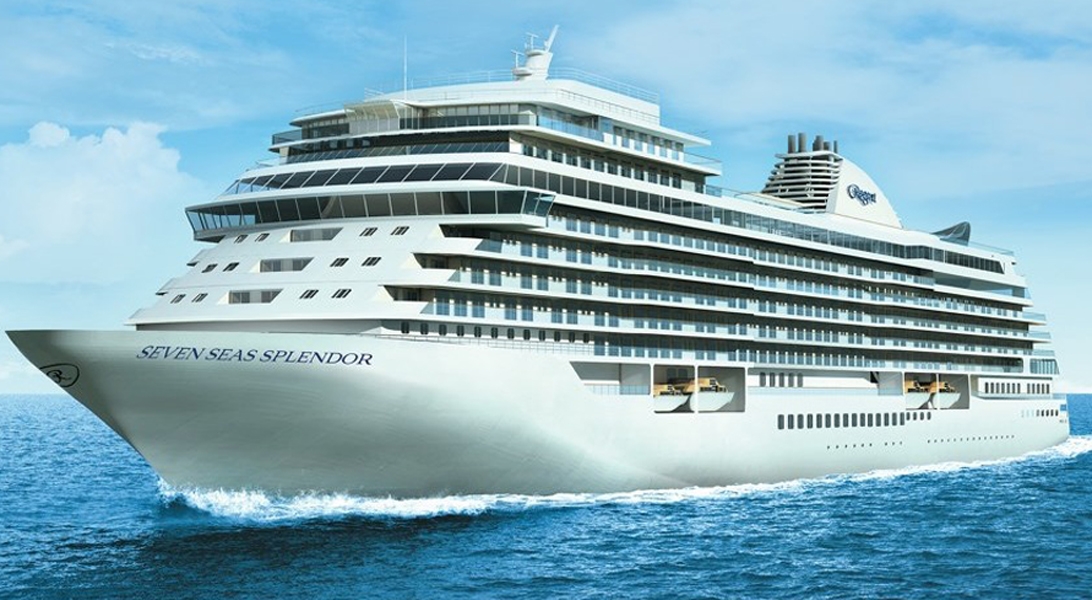
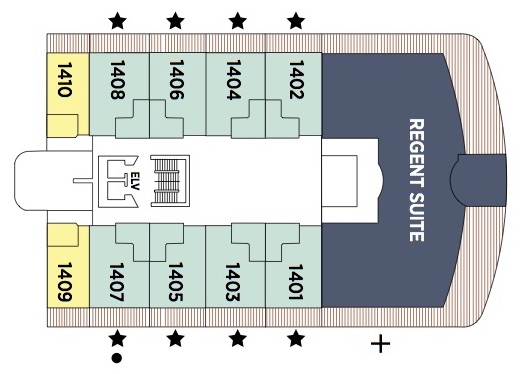









The images shown are for illustration purposes only and may not be an exact representation of what you find on the ship.
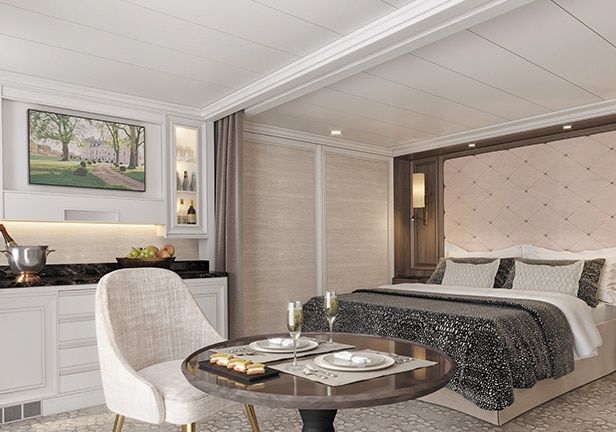
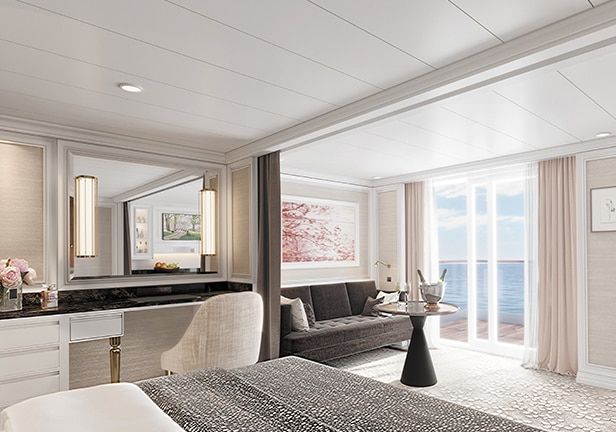
| Grade Code | From | To | |
| E | Concierge Suite | £16,159 | £19,659 |
| D | Concierge Suite | £16,849 | £20,349 |
In this superbly designed suite, enjoy once-in-a-lifetime views of the horizon from the comfort of your King-Sized Elite Slumber™ Bed as well as exclusive luxuries available only in suites at the Concierge level and higher. Your suite includes amenities such as an illy® espresso maker and cashmere blankets, perfect for use in the morning when you wish to sip coffee and enjoy an in-suite breakfast on your private balcony.
Layout
This category includes Accessibility Options in suites 822 and 823. For more information about accessible suites click here.
Amenities
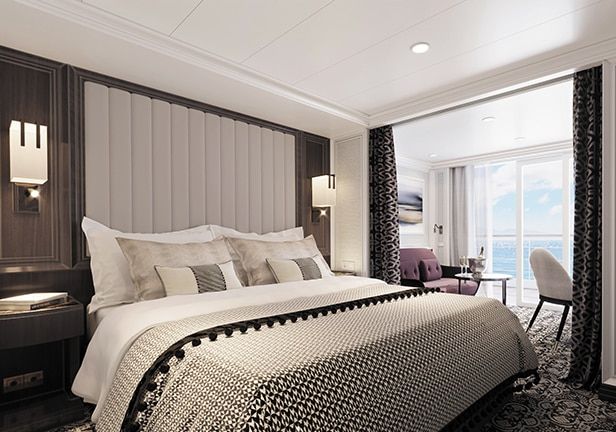
| Grade Code | From | To | |
| G2 | Deluxe Veranda Suite | £13,849 | £17,349 |
| G1 | Deluxe Veranda Suite | £14,159 | £17,659 |
Every inch of this suite has been thoughtfully designed to maximise interior space and embrace the magnificent scenery outdoors. From the sitting area, admire the ocean views through the floor-to-ceiling windows, or better yet, take a seat outside on your private balcony to watch the world go by. Elegant finishes such as luxurious bedding and beautiful marble detailing in the bath further enhance your comfort.
Layout
Amenities
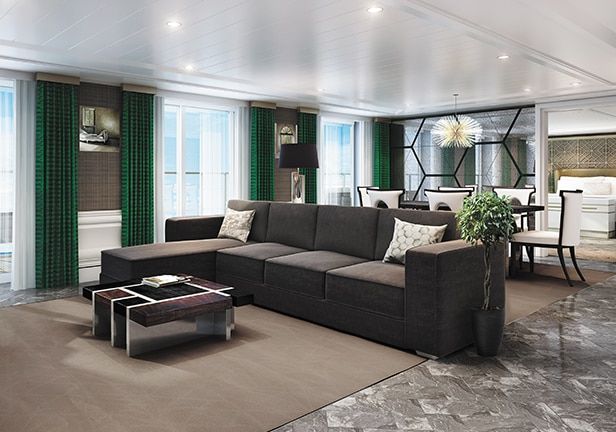
| Grade Code | From | To | |
| GS | Grand Suite | £36,699 | £40,199 |
Step into the richness of an emerald green dining area perfectly ensconced within a spacious, sumptuous living room. Just outside is a private balcony with a table and chairs, perfect for in-suite breakfast. The private bedroom is large and inviting, its soothing colour palette perfect for a peaceful night’s rest on your King-Size Elite Slumber™ Bed. Two full baths make it a perfect space for entertaining new friends on the high seas.
The suite pictured may differ from the suite booked, as layouts and designs vary by ship, deck, and suite location.
Layout
Amenities
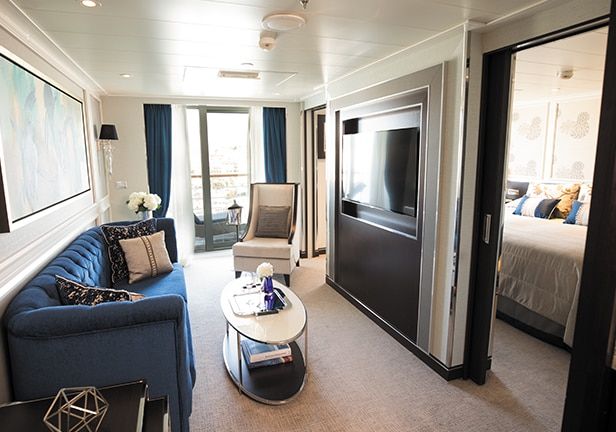
| Grade Code | From | To | |
| C | Penthouse Suite | £20,769 | £24,269 |
| B | Penthouse Suite | £21,469 | £24,969 |
| A | Penthouse Suite | £22,159 | £25,659 |
Your personal haven at the end of each day, this luxurious suite has been carefully designed to maximise space and comfort. Relax on your private balcony and indulge in your lavish bath amenities as you recharge and ready yourself for a new adventure in the next port of call. This suite also features a spacious walk-through closet and separated living and bedroom areas that can be closed with pocket doors for privacy.
Layout
Amenities
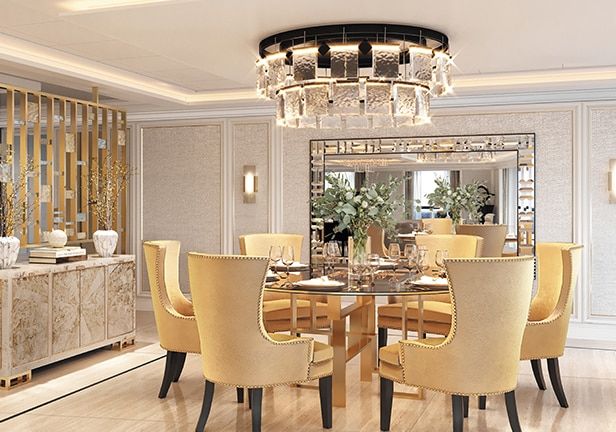
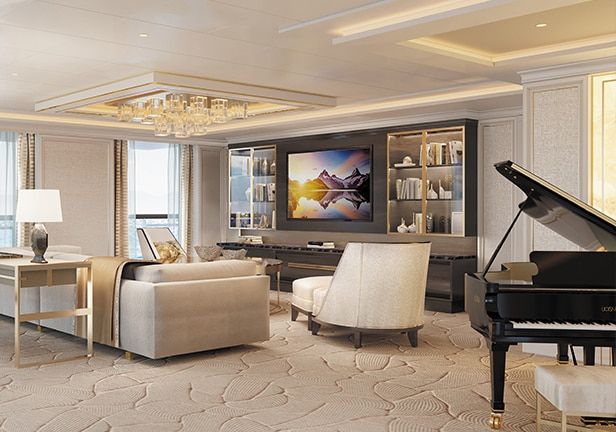
| Grade Code | From | To | |
| RS | Regent Suite | £132,689 | £136,189 |
High atop the ship, this suite of more than 4,000 square feet (372 meters) rises above everything else at sea. Incomparable craftsmanship and meticulous attention to detail are evident in everything from the unique design choices, such as rare works of art, to grand features like an in-suite spa retreat — a first for any cruise ship. The only thing to rival the luxurious interior is the spectacular ocean view from the private balconies.
Layout
Amenities
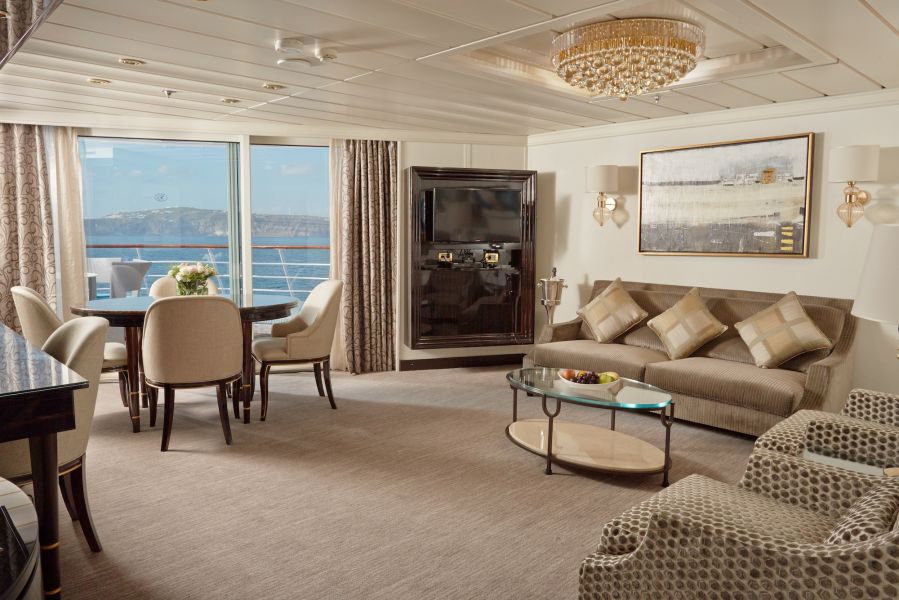
| Grade Code | From | To | |
| SS | Seven Seas Suite | £27,159 | £30,659 |
This suite is decorated with soothing colours, pleasing artwork and comfortable furnishings. Relax in the sitting area after an exciting day ashore and enjoy the selection of fresh canapés delivered by your personal butler. Then retreat to your private balcony to watch the ever-changing vistas.
Layout
Amenities
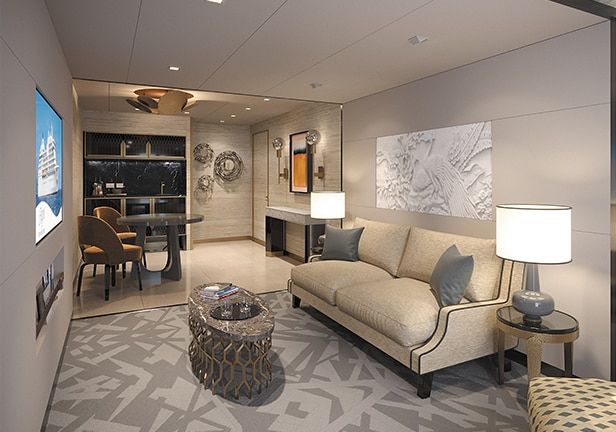
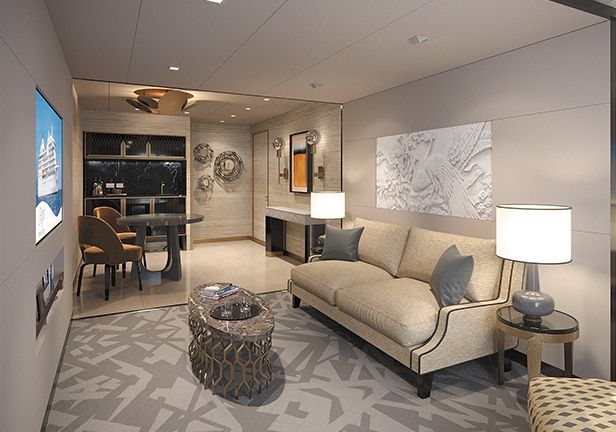
| Grade Code | From | To | |
| SP | Splendor Suite | £32,229 | £35,729 |
This home away from home is larger than some penthouse apartments, with more than 900 square feet (274.3 meters) of living space that includes a large private balcony. The sleek design provides ample space for relaxing or entertaining, and the walk-in closet comfortably stores your belongings. As if having a personal butler and daily canapés weren’t enough, you’ll also enjoy a personalised full-liquor bar set-up and a sumptuous in-suite caviar service.
Layout
Amenities
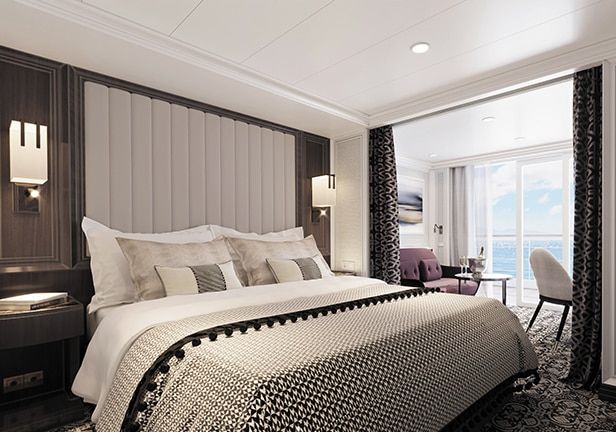
| Grade Code | From | To | |
| H | Veranda Suite | £13,159 | £16,659 |
A wonderfully cozy retreat that includes a private balcony. In addition to a signature European Queen Size Elite Slumber™ bed, you’ll enjoy amenities such as lavish bath products, an interactive flat-screen television and a plush bathrobe and slippers. The intimate sitting area includes a table that is the perfect size for breakfast for two or a couple of glasses and a bottle of celebratory Champagne.
Layout
Amenities
The images shown are for illustration purposes only and may not be an exact representation of what you find on the ship.
The images shown are for illustration purposes only and may not be an exact representation of what you find on the ship.
The images shown are for illustration purposes only and may not be an exact representation of what you find on the ship.
The images shown are for illustration purposes only and may not be an exact representation of what you find on the ship.
| Return flights including luggage allowance | |||
| Overseas Transfers | |||
| 23 nights aboard the Seven Seas Splendor | |||
| Free Luxury Hotel Package in Concierge Suites and Higher | |||
| Free Unlimited Shore Excursions | |||
| Free Speciality Restaurants | |||
| Free Unlimited Beverages Including Fine Wines | |||
| Free In-Suite Mini Bar Replenished Daily | |||
| Free Pre-Paid Gratuities | |||
| Free Wifi Throughout the Ship | |||
| Free Transfers Between Airport and Ship | |||
| Free 24 Hour Room Service | |||
| Port Taxes and Fees | |||
 | ABTA and ATOL Protection* | ||
Fly/cruise package |
Date 17th Oct 2027 |
Nts 23 |
Balcony £13,159pp |
Suite £16,159pp |
Balcony £13,679pp |
Suite £16,679pp |
Balcony £13,679pp |
Suite £16,679pp |
Balcony £13,679pp |
Suite £16,679pp |
Balcony £13,679pp |
Suite £16,679pp |
Balcony £13,679pp |
Suite £16,679pp |
Balcony £13,679pp |
Suite £16,679pp |
Balcony £13,679pp |
Suite £16,679pp |
Balcony £13,679pp |
Suite £16,679pp |
Balcony £13,679pp |
Suite £16,679pp |
Date 17th Oct 2027 |
Nts 23 |
Balcony £13,159pp |
Suite £16,159pp |
Balcony £13,679pp |
Suite £16,679pp |
Balcony £13,679pp |
Suite £16,679pp |
Balcony £13,679pp |
Suite £16,679pp |
Balcony £13,679pp |
Suite £16,679pp |
Balcony £13,679pp |
Suite £16,679pp |
Balcony £13,679pp |
Suite £16,679pp |
Balcony £13,679pp |
Suite £16,679pp |
Balcony £13,679pp |
Suite £16,679pp |
Balcony £13,679pp |
Suite £16,679pp |
| Balcony staterooms from | £13,159pp | ||
| H | Veranda Suite | £13,159pp | |
| G2 | Deluxe Veranda Suite | £13,849pp | |
| G1 | Deluxe Veranda Suite | £14,159pp | |
| F2 | Serenity Suite | £14,849pp | |
| F1 | Serenity Suite | £15,309pp | |
| Suite staterooms from | £16,159pp | ||
| E | Concierge Suite | £16,159pp | |
| D | Concierge Suite | £16,849pp | |
| C | Penthouse Suite | £20,769pp | |
| B | Penthouse Suite | £21,469pp | |
| A | Penthouse Suite | £22,159pp | |
| SS | Seven Seas Suite | £27,159pp | |
| SP | Splendor Suite | £32,229pp | |
| GS | Grand Suite | £36,699pp | |
| RS | Regent Suite |  | |
| SG | Signature Suite | £46,699pp | |
| Balcony staterooms from | £13,679pp | ||
| H | Veranda Suite | £13,679pp | |
| G2 | Deluxe Veranda Suite | £14,369pp | |
| G1 | Deluxe Veranda Suite | £14,679pp | |
| F2 | Serenity Suite | £15,369pp | |
| F1 | Serenity Suite | £15,829pp | |
| Suite staterooms from | £16,679pp | ||
| E | Concierge Suite | £16,679pp | |
| D | Concierge Suite | £17,369pp | |
| C | Penthouse Suite | £21,289pp | |
| B | Penthouse Suite | £21,989pp | |
| A | Penthouse Suite | £22,679pp | |
| SS | Seven Seas Suite | £27,679pp | |
| SP | Splendor Suite | £32,749pp | |
| GS | Grand Suite | £37,219pp | |
| RS | Regent Suite |  | |
| SG | Signature Suite | £47,219pp | |
| Balcony staterooms from | £13,679pp | ||
| H | Veranda Suite | £13,679pp | |
| G2 | Deluxe Veranda Suite | £14,369pp | |
| G1 | Deluxe Veranda Suite | £14,679pp | |
| F2 | Serenity Suite | £15,369pp | |
| F1 | Serenity Suite | £15,829pp | |
| Suite staterooms from | £16,679pp | ||
| E | Concierge Suite | £16,679pp | |
| D | Concierge Suite | £17,369pp | |
| C | Penthouse Suite | £21,289pp | |
| B | Penthouse Suite | £21,989pp | |
| A | Penthouse Suite | £22,679pp | |
| SS | Seven Seas Suite | £27,679pp | |
| SP | Splendor Suite | £32,749pp | |
| GS | Grand Suite | £37,219pp | |
| RS | Regent Suite |  | |
| SG | Signature Suite | £47,219pp | |
| Balcony staterooms from | £13,679pp | ||
| H | Veranda Suite | £13,679pp | |
| G2 | Deluxe Veranda Suite | £14,369pp | |
| G1 | Deluxe Veranda Suite | £14,679pp | |
| F2 | Serenity Suite | £15,369pp | |
| F1 | Serenity Suite | £15,829pp | |
| Suite staterooms from | £16,679pp | ||
| E | Concierge Suite | £16,679pp | |
| D | Concierge Suite | £17,369pp | |
| C | Penthouse Suite | £21,289pp | |
| B | Penthouse Suite | £21,989pp | |
| A | Penthouse Suite | £22,679pp | |
| SS | Seven Seas Suite | £27,679pp | |
| SP | Splendor Suite | £32,749pp | |
| GS | Grand Suite | £37,219pp | |
| RS | Regent Suite |  | |
| SG | Signature Suite | £47,219pp | |
| Balcony staterooms from | £13,679pp | ||
| H | Veranda Suite | £13,679pp | |
| G2 | Deluxe Veranda Suite | £14,369pp | |
| G1 | Deluxe Veranda Suite | £14,679pp | |
| F2 | Serenity Suite | £15,369pp | |
| F1 | Serenity Suite | £15,829pp | |
| Suite staterooms from | £16,679pp | ||
| E | Concierge Suite | £16,679pp | |
| D | Concierge Suite | £17,369pp | |
| C | Penthouse Suite | £21,289pp | |
| B | Penthouse Suite | £21,989pp | |
| A | Penthouse Suite | £22,679pp | |
| SS | Seven Seas Suite | £27,679pp | |
| SP | Splendor Suite | £32,749pp | |
| GS | Grand Suite | £37,219pp | |
| RS | Regent Suite |  | |
| SG | Signature Suite | £47,219pp | |
| Balcony staterooms from | £13,679pp | ||
| H | Veranda Suite | £13,679pp | |
| G2 | Deluxe Veranda Suite | £14,369pp | |
| G1 | Deluxe Veranda Suite | £14,679pp | |
| F2 | Serenity Suite | £15,369pp | |
| F1 | Serenity Suite | £15,829pp | |
| Suite staterooms from | £16,679pp | ||
| E | Concierge Suite | £16,679pp | |
| D | Concierge Suite | £17,369pp | |
| C | Penthouse Suite | £21,289pp | |
| B | Penthouse Suite | £21,989pp | |
| A | Penthouse Suite | £22,679pp | |
| SS | Seven Seas Suite | £27,679pp | |
| SP | Splendor Suite | £32,749pp | |
| GS | Grand Suite | £37,219pp | |
| RS | Regent Suite |  | |
| SG | Signature Suite | £47,219pp | |
| Balcony staterooms from | £13,679pp | ||
| H | Veranda Suite | £13,679pp | |
| G2 | Deluxe Veranda Suite | £14,369pp | |
| G1 | Deluxe Veranda Suite | £14,679pp | |
| F2 | Serenity Suite | £15,369pp | |
| F1 | Serenity Suite | £15,829pp | |
| Suite staterooms from | £16,679pp | ||
| E | Concierge Suite | £16,679pp | |
| D | Concierge Suite | £17,369pp | |
| C | Penthouse Suite | £21,289pp | |
| B | Penthouse Suite | £21,989pp | |
| A | Penthouse Suite | £22,679pp | |
| SS | Seven Seas Suite | £27,679pp | |
| SP | Splendor Suite | £32,749pp | |
| GS | Grand Suite | £37,219pp | |
| RS | Regent Suite |  | |
| SG | Signature Suite | £47,219pp | |
| Balcony staterooms from | £13,679pp | ||
| H | Veranda Suite | £13,679pp | |
| G2 | Deluxe Veranda Suite | £14,369pp | |
| G1 | Deluxe Veranda Suite | £14,679pp | |
| F2 | Serenity Suite | £15,369pp | |
| F1 | Serenity Suite | £15,829pp | |
| Suite staterooms from | £16,679pp | ||
| E | Concierge Suite | £16,679pp | |
| D | Concierge Suite | £17,369pp | |
| C | Penthouse Suite | £21,289pp | |
| B | Penthouse Suite | £21,989pp | |
| A | Penthouse Suite | £22,679pp | |
| SS | Seven Seas Suite | £27,679pp | |
| SP | Splendor Suite | £32,749pp | |
| GS | Grand Suite | £37,219pp | |
| RS | Regent Suite |  | |
| SG | Signature Suite | £47,219pp | |
| Balcony staterooms from | £13,679pp | ||
| H | Veranda Suite | £13,679pp | |
| G2 | Deluxe Veranda Suite | £14,369pp | |
| G1 | Deluxe Veranda Suite | £14,679pp | |
| F2 | Serenity Suite | £15,369pp | |
| F1 | Serenity Suite | £15,829pp | |
| Suite staterooms from | £16,679pp | ||
| E | Concierge Suite | £16,679pp | |
| D | Concierge Suite | £17,369pp | |
| C | Penthouse Suite | £21,289pp | |
| B | Penthouse Suite | £21,989pp | |
| A | Penthouse Suite | £22,679pp | |
| SS | Seven Seas Suite | £27,679pp | |
| SP | Splendor Suite | £32,749pp | |
| GS | Grand Suite | £37,219pp | |
| RS | Regent Suite |  | |
| SG | Signature Suite | £47,219pp | |
| Balcony staterooms from | £13,679pp | ||
| H | Veranda Suite | £13,679pp | |
| G2 | Deluxe Veranda Suite | £14,369pp | |
| G1 | Deluxe Veranda Suite | £14,679pp | |
| F2 | Serenity Suite | £15,369pp | |
| F1 | Serenity Suite | £15,829pp | |
| Suite staterooms from | £16,679pp | ||
| E | Concierge Suite | £16,679pp | |
| D | Concierge Suite | £17,369pp | |
| C | Penthouse Suite | £21,289pp | |
| B | Penthouse Suite | £21,989pp | |
| A | Penthouse Suite | £22,679pp | |
| SS | Seven Seas Suite | £27,679pp | |
| SP | Splendor Suite | £32,749pp | |
| GS | Grand Suite | £37,219pp | |
| RS | Regent Suite |  | |
| SG | Signature Suite | £47,219pp | |
Fusion Cruises when selling travel arrangements is a trading name of The Midcounties Co-operative Ltd. Fusion Cruises is an Accredited Body Member of Midcounties Co-operative Travel Consortium. (ABTA:P6652, ATOL:6053).
Book with Confidence. We are a Member of ABTA which means you have the benefit of ABTA’s assistance and Code of Conduct.
Some of the flights and flight-inclusive holidays on this website are financially protected by the ATOL scheme but ATOL protection does not apply to all holiday and travel services offered on this website. This website will provide you with information on the protection that applies in the case of each holiday and travel service offered before you make your booking. If you do not receive an ATOL Certificate then the booking will not be ATOL protected. If you do receive an ATOL Certificate but all parts of your trip are not listed on it, those parts will not be ATOL protected. Please see our booking conditions for information, or for more information about financial protection and the ATOL Certificate go to: www.caa.co.uk
